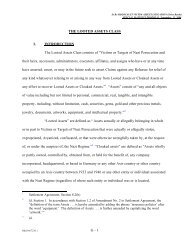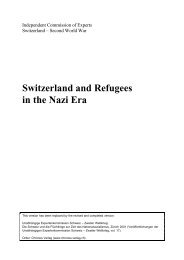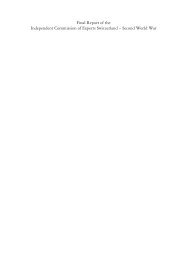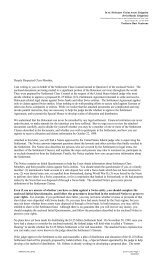Switzerland and Gold Transactions in the Second World War
Switzerland and Gold Transactions in the Second World War
Switzerland and Gold Transactions in the Second World War
Create successful ePaper yourself
Turn your PDF publications into a flip-book with our unique Google optimized e-Paper software.
Interim Report on <strong>Gold</strong><br />
14<br />
Introduction<br />
become accessible to <strong>the</strong> general public until 1973, <strong>and</strong> <strong>the</strong>re was little research <strong>in</strong>to<br />
<strong>Switzerl<strong>and</strong></strong>’s economic <strong>and</strong> f<strong>in</strong>ancial co-operation with Nazi Germany. In 1962, <strong>the</strong> Federal<br />
Council commissioned Edgar Bonjour to prepare a study concern<strong>in</strong>g <strong>Switzerl<strong>and</strong></strong>’s neutrality.<br />
He was given full access to relevant sources, <strong>and</strong> focused on gold received from <strong>the</strong> Allies.<br />
Indeed, <strong>the</strong> so-called «Bonjour Report», which appeared <strong>in</strong> 1970, 17 does not discuss looted<br />
gold shipped from Germany.<br />
The 1970s, however, witnessed a renewed <strong>in</strong>terest <strong>in</strong> historical aspects of Swiss-German<br />
<strong>in</strong>teraction. Daniel Frei’s 1969 study 18 exam<strong>in</strong>ed <strong>the</strong> 1946 Wash<strong>in</strong>gton Agreement, <strong>and</strong> was<br />
followed by Daniel Bourgeois’s 1974 dissertation «Le Troisième Reich et la Suisse», 19 which<br />
drew on German archival sources <strong>and</strong>, for <strong>the</strong> first time, discussed <strong>the</strong> ma<strong>in</strong> issues which<br />
concern us. Peter Utz’s article concern<strong>in</strong>g <strong>the</strong> scope <strong>and</strong> extent of <strong>the</strong> SNB’s gold transactions<br />
with Nazi Germany, published <strong>in</strong> April 1980, 20 proved a spr<strong>in</strong>gboard for later discussion. In<br />
1983, Hans-Ulrich Jost <strong>in</strong>tegrated his <strong>in</strong>terpretation of Swiss gold operations <strong>in</strong>to <strong>the</strong> chapter<br />
«Bedrohung und Enge» [Threats <strong>and</strong> Difficult Circumstances] <strong>in</strong> his «Geschichte der Schweiz<br />
– und der Schweizer» [History of <strong>Switzerl<strong>and</strong></strong> <strong>and</strong> <strong>the</strong> Swiss], 21 which <strong>in</strong>cluded a discussion of<br />
<strong>the</strong> war years. In his 1984 dissertation on Swiss-American f<strong>in</strong>ancial relations, Marco Durrer 22<br />
focused on gold received by <strong>Switzerl<strong>and</strong></strong> from <strong>the</strong> Allies, <strong>and</strong> Marc Perrenoud’s study<br />
concern<strong>in</strong>g <strong>the</strong> geographic distribution of <strong>Switzerl<strong>and</strong></strong>’s foreign assets 23 made an important<br />
contribution. The publicist <strong>and</strong> film writer Werner R<strong>in</strong>gs also discussed gold stolen by<br />
Germany <strong>in</strong> his book about <strong>Switzerl<strong>and</strong></strong>’s role as a market place for gold. 24 R<strong>in</strong>gs makes<br />
certa<strong>in</strong> counter-arguments concern<strong>in</strong>g <strong>the</strong> SNB Govern<strong>in</strong>g Board’s level of knowledge, but he<br />
made it clear that from <strong>the</strong> start <strong>the</strong> parties <strong>in</strong>volved swung wildly between profit-driven<br />
expediency <strong>and</strong> more morally <strong>in</strong>formed positions. Jakob Tanner’s 1986 dissertation focused on<br />
<strong>the</strong> extent to which flows of gold <strong>and</strong> capital <strong>in</strong>to <strong>Switzerl<strong>and</strong></strong> were macroeconomically<br />
<strong>in</strong>terconnected, <strong>and</strong> on how <strong>the</strong> Federal government <strong>in</strong>tervened <strong>in</strong> <strong>the</strong> SNB’s monetary <strong>and</strong><br />
currency policies via so-called «gold sterilization». Tanner’s study also shows how important<br />
<strong>Switzerl<strong>and</strong></strong> was to <strong>the</strong> Third Reich: s<strong>in</strong>ce Germany had been cut off by <strong>the</strong> Allied blockade,<br />
<strong>Switzerl<strong>and</strong></strong> provided it with access to world markets <strong>and</strong> allowed it to obta<strong>in</strong> strategically<br />
important materials such as tungsten, manganese, high grade iron-ore, <strong>and</strong> crude oil. 25<br />
17<br />
18<br />
19<br />
20<br />
21<br />
22<br />
23<br />
24<br />
25<br />
The «Bonjour Report» is generally considered to be volumes 3–6 of «Geschichte der schweizerischen Neutralität» [A<br />
History of Swiss Neutrality], published <strong>in</strong> 1970, by Professor Edgar Bonjour, University of Basel, cover<strong>in</strong>g <strong>the</strong> period<br />
from 1933–1945. Three fur<strong>the</strong>r volumes which <strong>in</strong>cluded sources appeared between 1970 <strong>and</strong> 1976. See Bonjour 1970–<br />
1976.<br />
Frei 1969.<br />
Bourgeois 1974; Bourgeois 1981.<br />
Utz 1980.<br />
Jost 1986.<br />
Durrer 1984.<br />
Perrenoud 1987/1988.<br />
R<strong>in</strong>gs 1996.<br />
Tanner 1986; Tanner 1990b. See also He<strong>in</strong>iger 1989.







